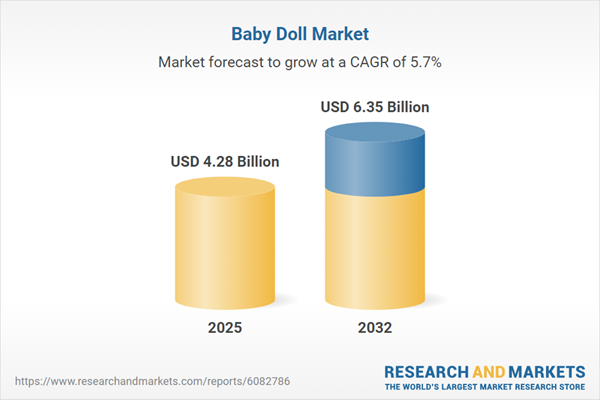Speak directly to the analyst to clarify any post sales queries you may have.
The baby doll market is experiencing dynamic evolution as brands respond to rapidly changing expectations in technology, sustainability, and cultural relevance. This environment, marked by innovation and shifting supply chains, presents strategic opportunities for stakeholders across the value chain.
Market Snapshot: Growth Trajectory of the Baby Doll Market
The baby doll market grew from USD 4.06 billion in 2024 to USD 4.28 billion in 2025 and is projected to reach USD 6.35 billion by 2032 at a CAGR of 5.73%. The sector’s expansion reflects robust demand from collectors, therapists, and families, with products continually adapting to new consumer, environmental, and technological expectations.
Scope & Segmentation: Strategic Breakdown of the Baby Doll Market
- Product Types: Character dolls, educational dolls, ethnic dolls, fantasy dolls, fashion dolls, interactive dolls (including singing and talking varieties).
- Material Types: Cloth (cotton, polyester), plastic, porcelain, rubber, silicone, vinyl (hard vinyl, soft vinyl).
- Manufacturing Methods: 3D-printed dolls, handmade dolls, machine-manufactured dolls.
- Age Groups: Below 3 years, 3–12 years, above 12 years.
- Sales Channels: Offline channels (department stores, gift shops, supermarkets/hypermarkets, toy stores) and online channels (brand websites, eCommerce platforms).
- Features & Functionalities: Collecting/display, emotional support/therapy, nurturing/role-playing, sensory development.
- Regional Focus: Americas (North America, Latin America), Europe, Middle East, Africa, Asia-Pacific—including specific country coverage across each region.
- Company Analysis: Coverage of major brands, specialty manufacturers, and emerging players in the sector.
Key Takeaways: Strategic Insights for Senior Decision-Makers
- Evolving consumer expectations are prompting manufacturers to blend nostalgic and modern interactive features, enhancing emotional engagement and educational value.
- Sustainability is reshaping both product design and manufacturing processes, with increasing adoption of eco-friendly materials and responsible sourcing to address environmental imperatives.
- Customization and digital integration are rapidly influencing product lines, as advancements in on-demand manufacturing and 3D printing unlock new routes to personalization and limited releases.
- Regional diversification of sales channels and product offerings is critical, driven by unique cultural dynamics and local regulatory requirements across global markets.
- Collaborative innovation—including strategic alliances and data-driven product development—supports faster adaptation and responsiveness to emerging trends.
Tariff Impact: Adapting Cost Structures and Supply Chains
Recent tariff changes have prompted manufacturers to reassess sourcing and production, accelerating nearshoring initiatives and expanding supplier networks to mitigate risks. Brands are leveraging new materials and forming diverse partnerships to balance pricing strategies while maintaining product integrity. These shifts highlight the importance of resilient, flexible supply chains in an unpredictable geopolitical context.
Methodology & Data Sources
This report draws on primary interviews with industry leaders, designers, and retail specialists, supplemented by extensive secondary research including regulatory documents, trade reports, and patent reviews. Data validation and cross-referencing ensure that findings are comprehensive and support informed strategy.
Why This Report Matters: Actionable Value for Industry Leaders
- Enables executives to benchmark current strategies against industry trends in material innovation, customization, and supply chain optimization.
- Supports product portfolio and market entry decisions with clear segmentation, competitive analysis, and actionable risk mitigation insights.
Conclusion
The baby doll market is undergoing significant transformation driven by innovation, sustainability, and evolving global dynamics. Stakeholders equipped with timely insights can position themselves for sustained growth and competitive distinction as the industry advances.
Table of Contents
3. Executive Summary
4. Market Overview
7. Cumulative Impact of Artificial Intelligence 2025
Companies Mentioned
The companies profiled in this Baby Doll market report include:- Adora
- Bigjigs Toys Ltd
- Cabbage Patch Kids
- Corolle SAS
- HABA USA
- Hamleys by Reliance Brands Limited
- Hasbro, Inc.
- Hunter Products Pty Ltd
- JAKKS Pacific, Inc.
- JC TOYS GROUP, INC.
- LEGO Group
- Madame Alexander Doll Company
- Mattel, Inc.
- MGA Entertainment Inc.
- MINILAND S.A.
- Muñecas Paola Reina S.L.
- Paradise Galleries
- Spin Master Corp.
- The Ashton-Drake Galleries
- Tomy Company, Ltd.
- TOYSMITH CORPORATION
- Walt Disney Company
- Zapf Creation AG
- American Girl, LLC
Table Information
| Report Attribute | Details |
|---|---|
| No. of Pages | 190 |
| Published | November 2025 |
| Forecast Period | 2025 - 2032 |
| Estimated Market Value ( USD | $ 4.28 Billion |
| Forecasted Market Value ( USD | $ 6.35 Billion |
| Compound Annual Growth Rate | 5.7% |
| Regions Covered | Global |
| No. of Companies Mentioned | 25 |









